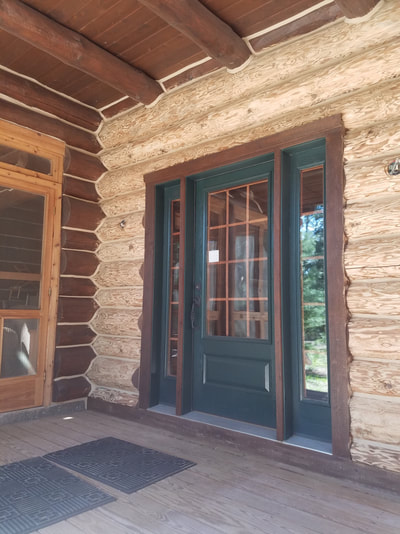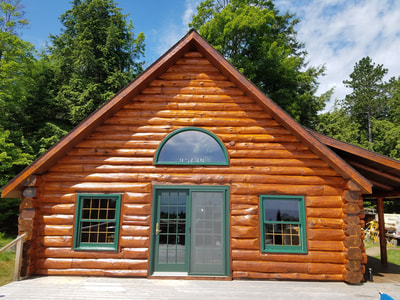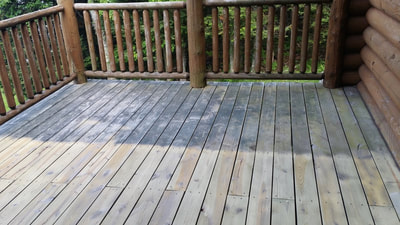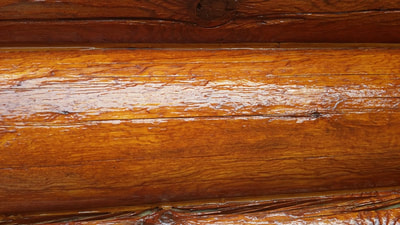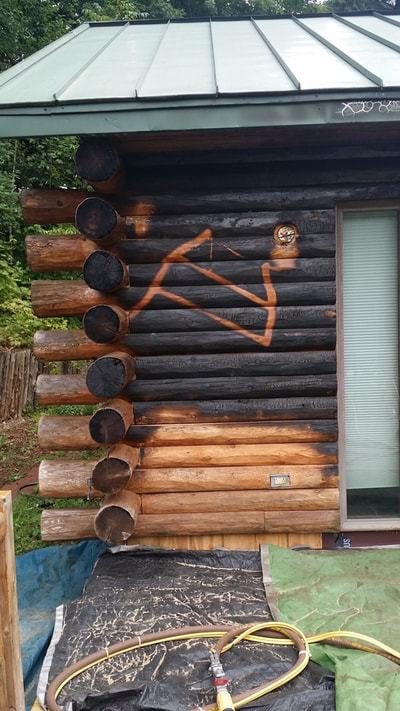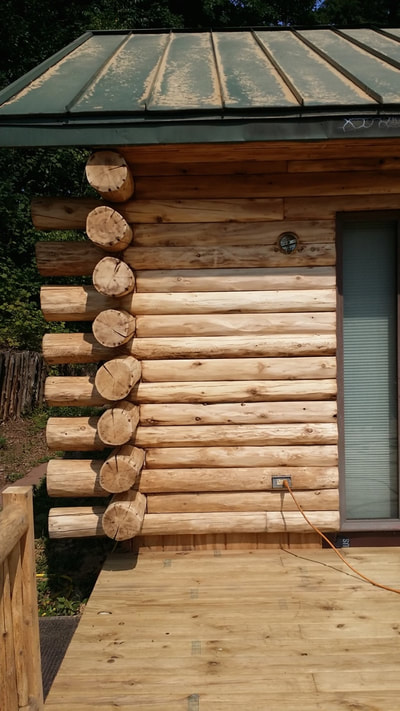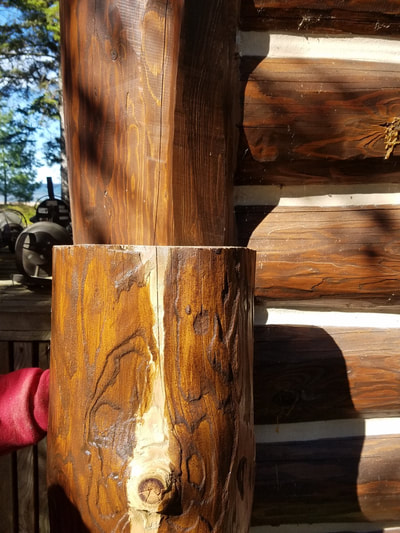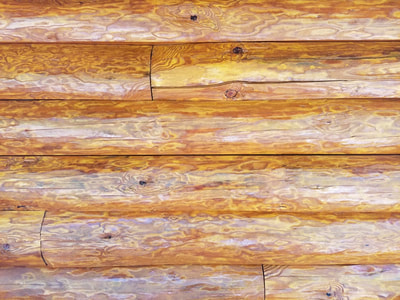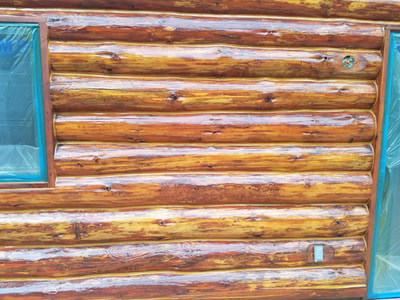There are many myths and alternative facts on the Internet about media blasting. Media blasting is a form of removing stain, paints, debris, and other coatings from a substrate with compressed air or steam which accelerate a particle or media that removes the finish on impact. Let’s talk about the types of media used on logs, wood and metal in this article. The first point about media blasting, its not something that most homeowners or inexperienced contractor should undertake. It is more difficult than you may think when you want to remove a finish from coated logs with media. It is one of the most technical things that a log restoration contractor can undertake. The years of experience needed to properly media blast and full understanding of how the coating and logs will react are intense. For this reason before an employee will be eligible for training on the nozzle they have to complete two seasons tending the blast pot. Once they can operate the blast pot and know when the blaster needs more or less media flow, manage the moisture, set up and take down, maintain the compressor and install masking that doesn’t fail without me having to communicate then they are ready to start phase two…Blasting.
Proper Equipment is second to trained workers. When we media blast a log home be ready for a yard or job site full of equipment, truck, trailers and materials. When we start blasting we have to have everything in place. The structure has to be masked, drop clothes placed, tool trailer, blast trailer, media, fuel and staging all have to be set and on site. Having good quality equipment is expensive at first but saves in the long run. I prefer using Clemco for my blast equipment. My local contractor supply Midway Rentals and Sales carries the best stuff money can buy and they carry clemco so service and parts are a breeze.
What do we have to consider before we “pull the trigger”? Number one is everything masked and are fixtures removed or protected. Media blasting is extremely abrasive and if we splatter some objects with media the consequences may be undesirable. We will usually do are high risk and delicate areas with corn media to minimize the risk of etching delicate areas. Due to the fact that corn is slower and tends to fuzz wood after we cut in we change media. Ground glass is the second course of action on logs. Ground glass cuts through the toughest coatings and leaves less texture and profiles the wood less than corn. Due to the fact that is has sharp edges and cuts much like tiny chisels. Glass is definitely harder to use than other media but it is the fastest and leaves the best finish. Some contractors prefer walnut hulls and too I like to use it but, the price point is much higher so I stick with ground glass. How about slag abrasive? I did an experiment with slag abrasive on logs. Yes it cuts fast the only problem is it will turn your logs the color of the slag for example in my experiment coal slag turned the logs black. Save the slag abrasive for metal projects. If money wasn’t a barrier I would love to experiment with a Dry ice rig. When the blasting is done there is no media to pick up because the dry ice is lost to sublimation. Other media such as glass beads, steel shot , steel grit and plastic beads don’t work well on logs. Now you may be asking yourself why aren’t I talking about sandblasting? Just google “OSHA Sandblasting rules” It’s complicated.
How about the weather? The dew point, humidity and temperature play a huge roll in how the media flows. Uneven media flow through the blasting pot and nozzle mean a bad end result. In other word if we are blasting a job be ready for job delays. If the dew point is 60 degrees fahrenheit and its 50 degrees at 7:00 A.M we probably won’t blast until 11:00 A.M. If the humidity spikes then we will be done for the day. Many times I have quit blasting and told the crew to clean up because a thunderstorm is coming. The usual response is everyone takes a brake to check their fancy weather app and they come back and say nothing is on the radar. After we clean up the storm blows through. How did I know? To a seasoned outdoor on the job media blaster we sense the smallest changes in humidity and in these cases the pot didn’t want to function. What is the problem? The large air compressors we use heats the air during compression. Heated air holds more moisture. Our air flows through water separators and air cooler however it isn’t always enough when it flows through the blast pot and mixes with the media. When media blasting outdoors the weather should be dry, above freezing, low humidity and a dew point above the temperature. That can be hard to get in the upper midwest.
Personal Protection Equipment (PPE) and what do we do? As always Eye protection is first on the list. The other thing most contractors fail to understand is making sure all employees and subcontractors have respirators. Blasting creates dust and when there is dust it’s time for respirators. Media blasting is loud and everyone on site needs to wear hearing protection when in the blast zone. I prefer to have no one on the job except my crew. I learned this from experience, many times I have been blasting and in the zone and out of my peripheral vision I can see bystanders standing in the work zone with no protection. It is a huge pain in the ASS to shut down and take off our PPE to kindly tell the curios people that this is a work zone and without the proper PPE they can’t be near us while blasting. So, if practicable I don’t want anyone on the job site other than the workers. In my spare time I research other Log Home Restoration Contractors. What I have read online and watched on YouTube raises some concern. There are companies that tape the nozzle to a stick and blast with safety glasses and a fiber respirator. I personally know guys that blast with beach sand with only cloth blast shields and cardboard spatter shields with no masking. We are not that kind of company. In my own opinion there is only one way to blast as a professional. Full pressurized face and upper body protection with air supplied from a clean environment. Heavy pants, eight inch boots, double long sleeve shirt and forearm gloves also make the job seamless. Yes it hot, yes it is alot to wear, the good news is we are protected and are safe at the end of the day.
People ask me if media blasting will ruin their logs. Here is the long and short answer. Will media blasting change the texture of your logs? Will media blasting raise the grain and profile of the wood? If you have planed logs then yes. Is the amount of texturing unacceptable? To most of my customers it is not unacceptable. It the customer doesn’t like the texture we have more labor intensive and thus expensive options if they need stained removed and want less texturing. The fact of the matter is that if you read the spec sheets for every log stain manufacturer most recommend removing all of the stain in order to guarantee their stain. Almost every stain manufacturer and supplier recommends media blasting as a way to remove stain. Why is this? Media blasting can remove the previous coatings if done properly and leaves a texture that allows for proper stain thickness or mils to be applied. Rough wood takes more stain and most stains last longer if mil thickness is what the spec calls for. After the blasting is done have a step that removes much of the texture. The question for the customer after they are educated is will the be comfortable with some texture? If they are still unsure, I have samples of different wood species that have been blasted and they can touch, feel and even apply the stains they are considering.
How fast is media blasting? Media blasting is the fastest, most efficient and when compared to chemical strippers more environmentally friendly. To do it correctly there are many steps such as masking, removing fixtures, tying back vegetation, setting up staging and cleaning up after the job. We would have to do all of these things if we were using other forms of stain removal so we are still ahead when we media blast.
One last thing to consider if you are going to have your house media blasted. If you have any air leaks we will find them. The dust and media will find its way into the home. We always have a shop vac on the job and clean up any dust that gets inside the building envelope as soon as it is found. If we identify leaks, then after blasting we can caulk or chink the voids when we are done blasting. Like I mentioned earlier the operation is loud, so if you are very sensitive to loud noises then it is something to consider. I have found that is hard for some customers when they have the house masked. Anytime we media blast or stain we mask the windows and doors. If the weather is very warm outside we will unmask a few windows and doors daily for ventilation. If we media blast you won’t be able to enjoy the view from inside the house for a little while. The good news is your house will be protected and when we are done the logs will look fresh and give you many years of protection. Below are some photos of media blasted logs and buildings from left to right.
Photos
- Finished Eastern white Cedar
- Example of control you have with media blasting
- Deck cleaning. Its bone dry and ready to stain the same day
- Close up of the texture
- Fire damaged log wall
- Same wall after media blasting with corn cob
- Example of finished wall
- Example of finished wall
- Matching stain to old stain. Test piece in front has been media blasted and back wall has not
[IMAGE PHOTO GALLERY]

